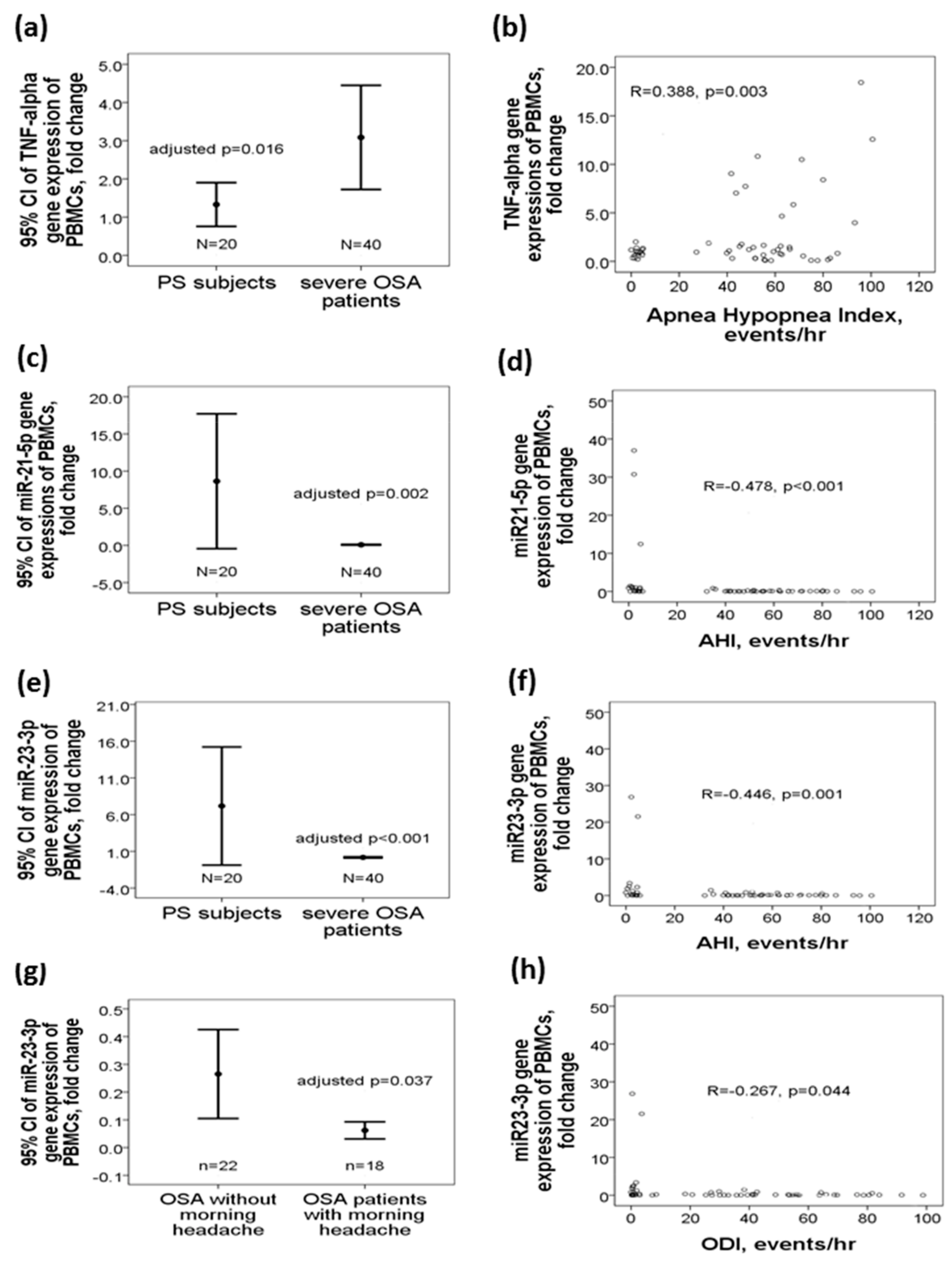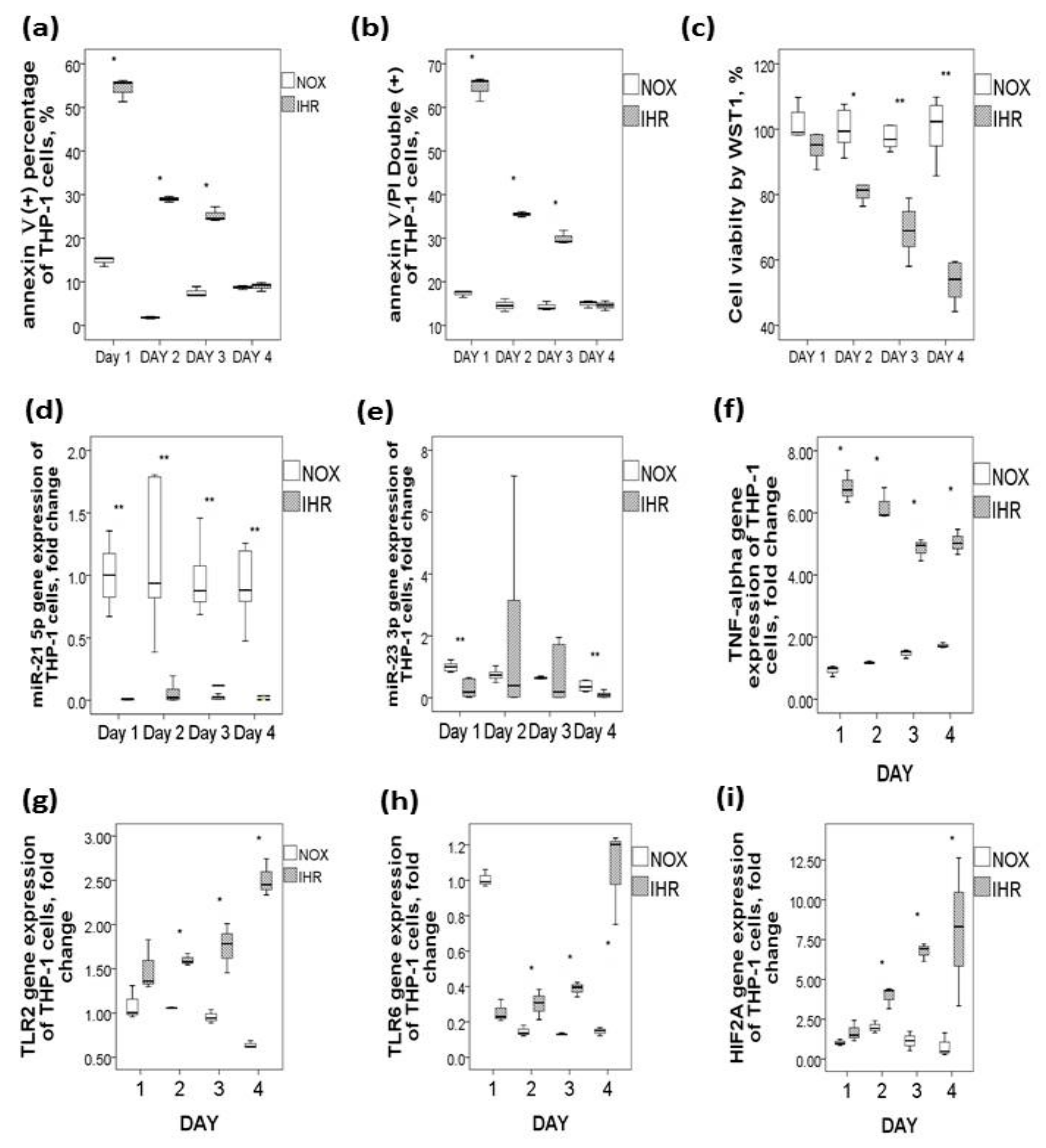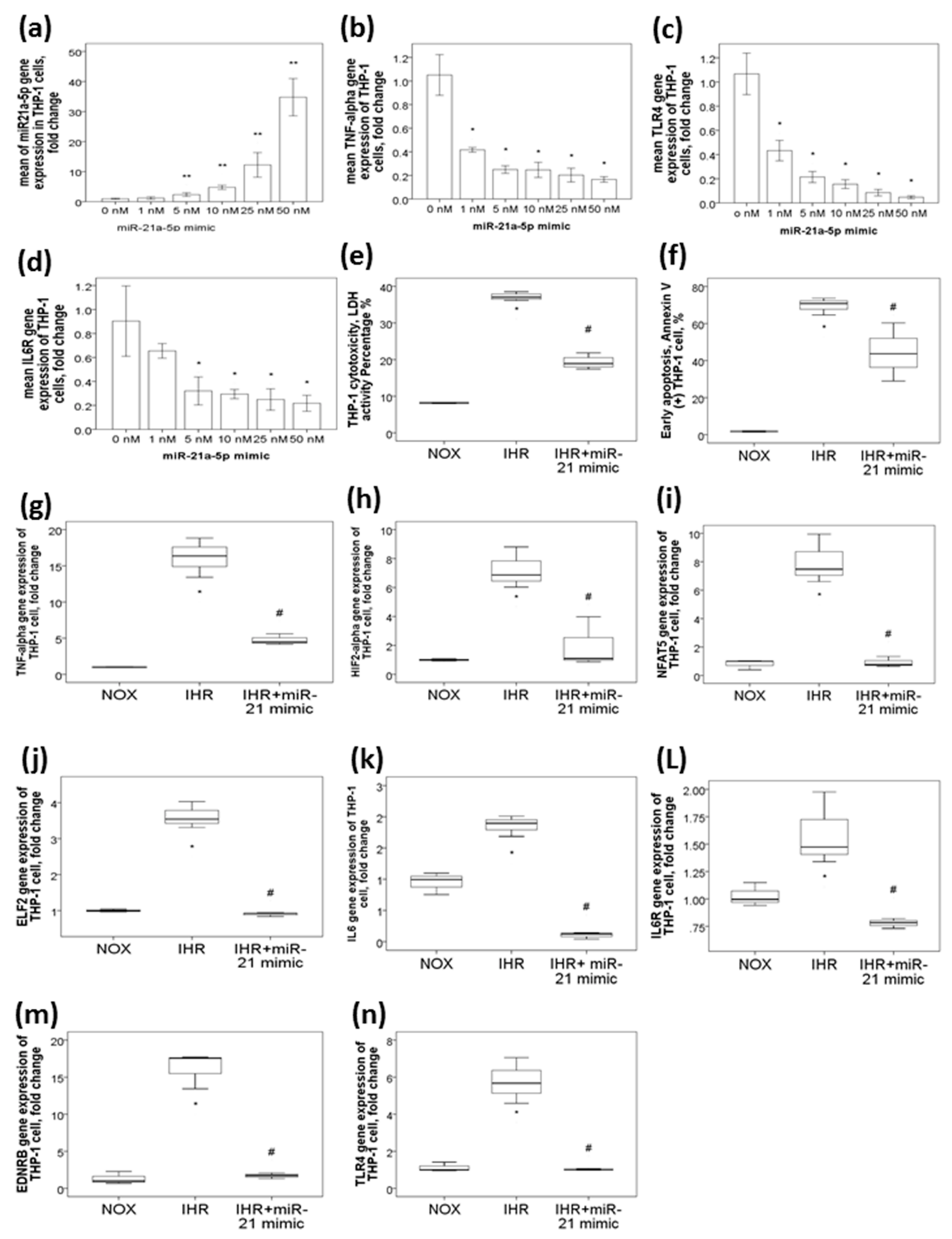miR-21-5p Under-Expression in Patients with Obstructive Sleep Apnea Modulates Intermittent Hypoxia with Re-Oxygenation-Induced-Cell Apoptosis and Cytotoxicity by Targeting Pro-Inflammatory TNF-α-TLR4 Signaling
Abstract
1. Introduction
2. Results
2.1. Decreased miR-21-5p/miR-23a-3p Gene Expressions and Increased TNF-α Gene Expression in OSA Patients
2.2. Effects of In Vitro IHR on the Two under-Expressed miRs and Their Predicted Target Gene Expressions in Human Monocytic THP-1 Cells
2.3. MiR-21-5p Mimic Represses TNF-α, IL-6R, and TLR4 Gene Expressions in THP-1 Cells under NOX Condition in a Dose-Dependent Manner
2.4. MiR-21-5p Mimic Transfection Suppressed IHR-Induced Cytotoxicity/Apoptosis and Inhibited IHR-Induced upregulations of Several Predicted Target Genes, Including TNF-α, HIF-2α, NFAT5, ELF2, IL6, IL6R, EDNRB, and TLR4
3. Discussion
4. Materials and Methods
4.1. Subjects
4.2. Overnight Polysomnography (PSG) Examination
4.3. Isolation of Leukocyte RNA
4.4. Analysis of miRNA
4.5. Determination of Target Gene mRNA Expressions of Isolated PBMCs Using Quantitative Reverse-Transcriptase Polymerase Chain Reaction (RT-PCR)
4.6. Transfection of miRNA-21-5p Mimic
4.7. In Vitro IHR Stimuli
4.8. Measurement of Cell Apoptosis by Flow Cytometry Analysis
4.9. Measurement of Cell Viability (Mitochondrial Activity) by WST-1
4.10. Measurement of Cytotoxicity (Cell Membrane Int.actness) by LDH Assay
4.11. Statistical Analysis
Author Contributions
Funding
Acknowledgments
Conflicts of Interest
Abbreviations
| OSA | Obstructive sleep apnea |
| SaO2 | Arterial oxyhemoglobin saturation |
| IHR | Intermittent hypoxia with re-oxygenation |
| TLR | Toll-like receptor |
| TNF | Tumor necrosis factor |
| miRNA | microRNA |
| AHI | Apnea hypopnea index |
| PS | Primary snoring |
| ODI | Oxygen desaturation index |
| ESS | Epworth sleepiness scale |
| BMI | Body mass index |
| RT-PCR | Reverse transcriptase |
| LDH | Lactate dehydrogenase |
References
- Veasey, S.C.; Rosen, I.M. Obstructive sleep apnea in adults. N. Engl. J. Med. 2019, 380, 1442–1449. [Google Scholar] [CrossRef] [PubMed]
- Chen, Y.C.; Hsu, P.Y.; Hsiao, C.C.; Lin, M.C. Epigenetics: A potential mechanism involved in the pathogenesis of various adverse consequences of obstructive sleep apnea. Int. J. Mol. Sci. 2019, 20, 2937. [Google Scholar] [CrossRef] [PubMed]
- Wang, X.; Zhang, Y.; Dong, Z.; Fan, J.; Nie, S.; Wei, Y. Effect of continuous positive airway pressure on long-term cardiovascular outcomes in patients with coronary artery disease and obstructive sleep apnea: A systematic review and meta-analysis. Respir. Res. 2018, 19, 61. [Google Scholar] [CrossRef] [PubMed]
- Yang, J.J.; Wang, S.J.; Gao, X.; Wang, B.; Dong, Y.T.; Bai, Y.; Chen, Y.; Gong, J.N.; Huang, Y.Q.; An, D.D. Toll-like receptor 4 (tlr-4) pathway promotes pulmonary inflammation in chronic intermittent hypoxia-induced obstructive sleep apnea. Med. Sci. Monit. 2018, 24, 7152–7161. [Google Scholar] [CrossRef] [PubMed]
- Wu, J.G.; Xun, N.; Zeng, L.J.; Li, Z.Y.; Liang, Y.B.; Tang, H.; Ma, Z.F. Effects of small interfering rna targeting tlr4 on expressions of adipocytokines in obstructive sleep apnea hyponea syndrome with hypertension in a rat model. J. Cell Physiol. 2018, 233, 6613–6620. [Google Scholar] [CrossRef] [PubMed]
- Chen, Y.C.; Su, M.C.; Liou, C.W.; Liu, S.F.; Chen, C.J.; Lin, H.C.; Hsiao, C.C.; Wang, T.Y.; Wang, C.C.; Chin, C.H.; et al. Co-upregulation of toll-like receptors 2 and 6 on peripheral blood cells in patients with obstructive sleep apnea. Sleep Breath 2015, 19, 873–882. [Google Scholar] [CrossRef]
- Akinnusi, M.; Jaoude, P.; Kufel, T.; El-Solh, A.A. Toll-like receptor activity in patients with obstructive sleep apnea. Sleep Breath 2013, 17, 1009–1016. [Google Scholar] [CrossRef]
- Li, Q.; Zheng, X. Tumor necrosis factor alpha is a promising circulating biomarker for the development of obstructive sleep apnea syndrome: A meta-analysis. Oncotarget 2017, 8, 27616–27626. [Google Scholar] [CrossRef]
- Merry, H.E.; Phelan, P.; Doaks, M.; Zhao, M.; Mulligan, M.S. Functional roles of tumor necrosis factor-alpha and interleukin 1-beta in hypoxia and reoxygenation. Ann. Thorac. Surg. 2015, 99, 1200–1205. [Google Scholar] [CrossRef]
- Chua, S.K.; Shyu, K.G.; Lin, Y.F.; Lo, H.M.; Wang, B.W.; Chang, H.; Lien, L.M. Tumor necrosis factor-alpha and the erk pathway drive chemerin expression in response to hypoxia in cultured human coronary artery endothelial cells. PLoS ONE 2016, 11, e0165613. [Google Scholar] [CrossRef]
- Paardekooper, L.M.; Bendix, M.B.; Ottria, A.; de Haer, L.W.; Ter Beest, M.; Radstake, T.; Marut, W.; van den Bogaart, G. Hypoxia potentiates monocyte-derived dendritic cells for release of tumor necrosis factor alpha via map3k8. Biosci. Rep. 2018, 38. [Google Scholar]
- Yang, N.; Wang, G.; Hu, C.; Shi, Y.; Liao, L.; Shi, S.; Cai, Y.; Cheng, S.; Wang, X.; Liu, Y.; et al. Tumor necrosis factor alpha suppresses the mesenchymal stem cell osteogenesis promoter mir-21 in estrogen deficiency-induced osteoporosis. J. Bone Min. Res. 2013, 28, 559–573. [Google Scholar] [CrossRef] [PubMed]
- Shi, J.H.; Sun, S.C. Tumor necrosis factor receptor-associated factor regulation of nuclear factor kappab and mitogen-activated protein kinase pathways. Front. Immunol. 2018, 9, 1849. [Google Scholar] [CrossRef] [PubMed]
- Quinn, S.R.; O’Neill, L.A. A trio of micrornas that control toll-like receptor signalling. Int.. Immunol. 2011, 23, 421–425. [Google Scholar] [CrossRef] [PubMed]
- Xu, K.; Xiao, J.; Zheng, K.; Feng, X.; Zhang, J.; Song, D.; Wang, C.; Shen, X.; Zhao, X.; Wei, C.; et al. Mir-21/stat3 signal is involved in odontoblast differentiation of human dental pulp stem cells mediated by tnf-alpha. Cell Reprogram 2018, 20, 107–116. [Google Scholar] [CrossRef]
- Yang, N.; Li, Y.; Wang, G.; Ding, Y.; Jin, Y.; Xu, Y. Tumor necrosis factor-alpha suppresses adipogenic and osteogenic differentiation of human periodontal ligament stem cell by inhibiting mir-21/spry1 functional axis. Differentiation 2017, 97, 33–43. [Google Scholar] [CrossRef]
- Lin, Q.; Geng, Y.; Zhao, M.; Lin, S.; Zhu, Q.; Tian, Z. Mir-21 regulates tnf-alpha-induced cd40 expression via the sirt1-nf-kappab pathway in renal inner medullary collecting duct cells. Cell Physiol. Biochem. 2017, 41, 124–136. [Google Scholar] [CrossRef]
- Barnett, R.E.; Conklin, D.J.; Ryan, L.; Keskey, R.C.; Ramjee, V.; Sepulveda, E.A.; Srivastava, S.; Bhatnagar, A.; Cheadle, W.G. Anti-inflammatory effects of mir-21 in the macrophage response to peritonitis. J. Leukoc. Biol. 2016, 99, 361–371. [Google Scholar] [CrossRef]
- Zhi, H.; Yuan, N.; Wu, J.P.; Lu, L.M.; Chen, X.Y.; Wu, S.K.; Mai, B.X. Microrna-21 attenuates bde-209-induced lipid accumulation in thp-1 macrophages by downregulating toll-like receptor 4 expression. Food Chem. Toxicol. 2019, 125, 71–77. [Google Scholar] [CrossRef]
- Xu, Z.; Sharma, M.; Gelman, A.; Hachem, R.; Mohanakumar, T. Significant role for microrna-21 affecting toll-like receptor pathway in primary graft dysfunction after human lung transplantation. J. Heart Lung Transpl. 2017, 36, 331–339. [Google Scholar] [CrossRef][Green Version]
- Wade, S.M.; Trenkmann, M.; McGarry, T.; Canavan, M.; Marzaioli, V.; Wade, S.C.; Veale, D.J.; Fearon, U. Altered expression of microrna-23a in psoriatic arthritis modulates synovial fibroblast pro-inflammatory mechanisms via phosphodiesterase 4b. J. Autoimmun. 2019, 96, 86–93. [Google Scholar] [CrossRef] [PubMed]
- Peng, P.; Li, Z.; Liu, X. Reduced expression of mir-23a suppresses a20 in tlr-stimulated macrophages. Inflammation 2015, 38, 1787–1793. [Google Scholar] [CrossRef] [PubMed]
- Chhabra, R.; Adlakha, Y.K.; Hariharan, M.; Scaria, V.; Saini, N. Upregulation of mir-23a-27a-24-2 cluster induces caspase-dependent and -independent apoptosis in human embryonic kidney cells. PLoS ONE 2009, 4, e5848. [Google Scholar] [CrossRef] [PubMed]
- Liang, Y.R.; Zhang, T.; Jia, P.; Xu, X.L.; Fang, Y.; Ding, X.Q. Interaction between bone marrow-derived dendritic cells and mir-21 of tubular renal epithelial cells under hypoxia. Eur. Rev. Med. Pharm. Sci. 2019, 23, 1641–1651. [Google Scholar]
- Hao, X.J.; Xu, C.Z.; Wang, J.T.; Li, X.J.; Wang, M.M.; Gu, Y.H.; Liang, Z.G. Mir-21 promotes proliferation and inhibits apoptosis of hepatic stellate cells through targeting pten/pi3k/akt pathway. J. Recept. Signal. Transduct. Res. 2018, 38, 455–461. [Google Scholar] [CrossRef] [PubMed]
- Chang, W.T.; Hsu, C.H.; Huang, T.L.; Tsai, Y.C.; Chiang, C.Y.; Chen, Z.C.; Shih, J.Y. Microrna-21 is associated with the severity of right ventricular dysfunction in patients with hypoxia-induced pulmonary hypertension. Acta Cardiol. Sin. 2018, 34, 511–517. [Google Scholar]
- Chang, C.H.; Yen, M.C.; Liao, S.H.; Hsu, Y.L.; Lai, C.S.; Kuo, Y.R.; Hsu, Y.L. Dual role of mir-21-mediated signaling in huvecs and rat surgical flap under normoxia and hypoxia condition. Int. J. Mol. Sci. 2017, 18, 1917. [Google Scholar] [CrossRef]
- Parikh, V.N.; Jin, R.C.; Rabello, S.; Gulbahce, N.; White, K.; Hale, A.; Cottrill, K.A.; Shaik, R.S.; Waxman, A.B.; Zhang, Y.Y.; et al. Microrna-21 integrates pathogenic signaling to control pulmonary hypertension: Results of a network bioinformatics approach. Circulation 2012, 125, 1520–1532. [Google Scholar] [CrossRef]
- Chen, T.; Yao, Q.; Wang, W.; Ye, Z.; Huang, Y.; Wu, M.; Xi, X. Involvement of androgen receptor (ar)/microrna-21 axis in hypoxia/reoxygenation-induced apoptosis of mouse renal tubular epithelial cells. Am. J. Transl. Res. 2019, 11, 5611–5622. [Google Scholar]
- Cheng, X.; Zhang, G.; Zhang, L.; Hu, Y.; Zhang, K.; Sun, X.; Zhao, C.; Li, H.; Li, Y.M.; Zhao, J. Mesenchymal stem cells deliver exogenous mir-21 via exosomes to inhibit nucleus pulposus cell apoptosis and reduce intervertebral disc degeneration. J. Cell Mol. Med. 2018, 22, 261–276. [Google Scholar] [CrossRef]
- Huang, Z.; Wu, S.; Kong, F.; Cai, X.; Ye, B.; Shan, P.; Huang, W. Microrna-21 protects against cardiac hypoxia/reoxygenation injury by inhibiting excessive autophagy in h9c2 cells via the akt/mtor pathway. J. Cell Mol. Med. 2017, 21, 467–474. [Google Scholar] [CrossRef] [PubMed]
- Yang, Q.; Yang, K.; Li, A. Microrna-21 protects against ischemia-reperfusion and hypoxia-reperfusion-induced cardiocyte apoptosis via the phosphatase and tensin homolog/akt-dependent mechanism. Mol. Med. Rep. 2014, 9, 2213–2220. [Google Scholar] [CrossRef] [PubMed]
- Zhang, T.; Ni, S.; Luo, Z.; Lang, Y.; Hu, J.; Lu, H. The protective effect of microrna-21 in neurons after spinal cord injury. Spinal Cord 2019, 57, 141–149. [Google Scholar] [CrossRef] [PubMed]
- Chen, R.; Tai, Y.; Zhang, Y.; Wang, L.; Yang, Y.; Yang, N.; Ma, S.; Xue, F.; Wang, J. Microrna-21 attenuates oxygen and glucose deprivation induced apoptotic death in human neural stem cells with inhibition of jnk and p38 mapk signaling. NeuroSci. Lett. 2019, 690, 11–16. [Google Scholar] [CrossRef]
- Mao, H.; Ding, L. Downregulation of mir-21 suppresses 1-methyl-4-phenylpyridinium-induced neuronal damage in mes23.5 cells. Exp. Ther. Med. 2019, 18, 2467–2474. [Google Scholar] [CrossRef] [PubMed]
- Song, N.; Zhang, T.; Xu, X.; Lu, Z.; Yu, X.; Fang, Y.; Hu, J.; Jia, P.; Teng, J.; Ding, X. Mir-21 protects against ischemia/reperfusion-induced acute kidney injury by preventing epithelial cell apoptosis and inhibiting dendritic cell maturation. Front. Physiol. 2018, 9, 790. [Google Scholar] [CrossRef]
- Chen, Q.; Xu, J.; Li, L.; Li, H.; Mao, S.; Zhang, F.; Zen, K.; Zhang, C.Y.; Zhang, Q. Microrna-23a/b and microrna-27a/b suppress apaf-1 protein and alleviate hypoxia-induced neuronal apoptosis. Cell Death Dis. 2014, 5, e1132. [Google Scholar] [CrossRef]
- Chen, X.; Liu, X.; Li, B.; Zhang, Q.; Wang, J.; Zhang, W.; Luo, W.; Chen, J. Cold inducible rna binding protein is involved in chronic hypoxia induced neuron apoptosis by down-regulating hif-1alpha expression and regulated by microrna-23a. Int. J. Biol. Sci. 2017, 13, 518–531. [Google Scholar] [CrossRef]
- Zhang, Y.; Peng, B.; Han, Y. Mir-23a regulates the proliferation and migration of human pulmonary artery smooth muscle cells (hpasmcs) through targeting bmpr2/smad1 signaling. Biomed. Pharm. 2018, 103, 1279–1286. [Google Scholar] [CrossRef]
- Hsu, Y.L.; Hung, J.Y.; Chang, W.A.; Lin, Y.S.; Pan, Y.C.; Tsai, P.H.; Wu, C.Y.; Kuo, P.L. Hypoxic lung cancer-secreted exosomal mir-23a increased angiogenesis and vascular permeability by targeting prolyl hydroxylase and tight junction protein zo-1. Oncogene 2017, 36, 4929–4942. [Google Scholar] [CrossRef]
- Gong, L.; Chang, H.; Zhang, J.; Guo, G.; Shi, J.; Xu, H. Astragaloside iv protects rat cardiomyocytes from hypoxia-induced injury by down-regulation of mir-23a and mir-92a. Cell Physiol. Biochem 2018, 49, 2240–2253. [Google Scholar] [CrossRef] [PubMed]
- Suzuki, J. Short-duration intermittent hypoxia enhances endurance capacity by improving muscle fatty acid metabolism in mice. Physiol. Rep. 2016, 4. [Google Scholar] [CrossRef] [PubMed]
- Roufayel, R.; Kadry, S. Expression of mir-23a by apoptotic regulators in human cancer: A review. Cancer Biol. Ther. 2017, 18, 269–276. [Google Scholar] [CrossRef] [PubMed]
- Ferini-Strambi, L.; Lombardi, G.E.; Marelli, S.; Galbiati, A. Neurological deficits in obstructive sleep apnea. Curr. Treat. Options Neurol. 2017, 19, 16. [Google Scholar] [CrossRef]
- Russell, M.B.; Kristiansen, H.A.; Kvaerner, K.J. Headache in sleep apnea syndrome: Epidemiology and pathophysiology. Cephalalgia 2014, 34, 752–755. [Google Scholar] [CrossRef]
- Hoffmann, M.S.; Singh, P.; Wolk, R.; Narkiewicz, K.; Somers, V.K. Obstructive sleep apnea and intermittent hypoxia increase expression of dual specificity phosphatase 1. Atherosclerosis 2013, 231, 378–383. [Google Scholar] [CrossRef]
- Dyugovskaya, L.; Polyakov, A.; Lavie, P.; Lavie, L. Delayed neutrophil apoptosis in patients with sleep apnea. Am. J. Respir. Crit. Care Med. 2008, 177, 544–554. [Google Scholar] [CrossRef]
- Berry, R.B.; Budhiraja, R.; Gottlieb, D.J.; Gozal, D.; Iber, C.; Kapur, V.K.; Marcus, C.L.; Mehra, R.; Parthasarathy, S.; Quan, S.F.; et al. Rules for scoring respiratory events in sleep: Update of the 2007 aasm manual for the scoring of sleep and associated events. Deliberations of the sleep apnea definitions task force of the american academy of sleep medicine. J. Clin. Sleep Med. 2012, 8, 597–619. [Google Scholar] [CrossRef]
- Johns, M.W. A new method for measuring daytime sleepiness: The epworth sleepiness scale. Sleep 1991, 14, 540–545. [Google Scholar] [CrossRef]



| PS Subjects (n = 20) | Severe OSA Patients (n = 40) | p-Value | |
|---|---|---|---|
| Age, years | 44.6 ± 14.3 | 47.6 ± 11 | 0.392 |
| Male Sex, n (%) | 15 (75) | 33 (82.5) | 0.432 |
| Body mass index, kg/m2 | 25 ± 3.1 | 25.9 ± 2.7 | 0.262 |
| AHI, events/hour | 2.8 ± 1.6 | 60.7. ± 11.3 | <0.001 |
| ODI, events/hour | 1.1 ± 0.9 | 48.9 ± 22.7 | <0.001 |
| Mean SaO2, % | 96.2 ± 1.3 | 93.3 ± 2.8 | <0.001 |
| Minimum SaO2, % | 89.2 ± 3.5 | 70 ± 12.6 | <0.001 |
| Snoring index, counts/hour | 114 ± 141 | 331 ± 145 | <0.001 |
| Epworth Sleepiness Scale | 8.5 ± 4.5 | 11.6 ± 5.2 | 0.034 |
| Excessive daytime sleepiness, n (%) | 5 (25) | 21 (53.8) | 0.048 |
| Smoking history, n (%) | 4 (20) | 15 (37.5) | 0.17 |
| Cholesterol, mg/dL | 189.5 ± 65 | 192.6 ± 32.3 | 0.822 |
| Triglycerides, mg/dL | 155.3 ± 224.9 | 149.9 ± 77.8 | 0.893 |
| Hypertension, n (%) | 5 (25) | 16 (40) | 0.305 |
| Diabetes mellitus, n (%) | 2 (10) | 4 (10) | 1 |
| Heart disease, n (%) | 3 (15) | 2 (5) | 0.186 |
| Stroke, n (%) | 1 (5) | 0 | 0.143 |
| Chronic kidney disease, n (%) | 1 (5) | 1 (2.5) | 0.584 |
| microRNA/Predicted Target Gene | TNF-α | TLR4 | TLR6 | NFAT5 | ELF2 | HIF-2α | EDNRB | SP1 | PDCD4 | IRF1 | Correlation Coefficient/p value |
|---|---|---|---|---|---|---|---|---|---|---|---|
| miR-21 | −0.431 | −0.386 | −0.436 | −0.473 | −0.569 | −0.429 | −0.545 | −0.604 | −0.653 | −0.359 | R |
| <0.001 | 0.003 | <0.001 | <0.001 | <0.001 | <0.001 | <0.001 | <0.001 | <0.001 | 0.005 | p | |
| miR-23a | −0.356 | −0.346 | −0.374 | −0.377 | −0.493 | −0.366 | −0.505 | −0.551 | −0.612 | −0.276 | R |
| 0.001 | 0.008 | 0.001 | 0.004 | <0.001 | 0.001 | <0.001 | <0.001 | <0.001 | 0.038 | p |
© 2020 by the authors. Licensee MDPI, Basel, Switzerland. This article is an open access article distributed under the terms and conditions of the Creative Commons Attribution (CC BY) license (http://creativecommons.org/licenses/by/4.0/).
Share and Cite
Chen, Y.-C.; Hsu, P.-Y.; Su, M.-C.; Chin, C.-H.; Liou, C.-W.; Wang, T.-Y.; Lin, Y.-Y.; Lee, C.P.; Lin, M.-C.; Hsiao, C.-C. miR-21-5p Under-Expression in Patients with Obstructive Sleep Apnea Modulates Intermittent Hypoxia with Re-Oxygenation-Induced-Cell Apoptosis and Cytotoxicity by Targeting Pro-Inflammatory TNF-α-TLR4 Signaling. Int. J. Mol. Sci. 2020, 21, 999. https://doi.org/10.3390/ijms21030999
Chen Y-C, Hsu P-Y, Su M-C, Chin C-H, Liou C-W, Wang T-Y, Lin Y-Y, Lee CP, Lin M-C, Hsiao C-C. miR-21-5p Under-Expression in Patients with Obstructive Sleep Apnea Modulates Intermittent Hypoxia with Re-Oxygenation-Induced-Cell Apoptosis and Cytotoxicity by Targeting Pro-Inflammatory TNF-α-TLR4 Signaling. International Journal of Molecular Sciences. 2020; 21(3):999. https://doi.org/10.3390/ijms21030999
Chicago/Turabian StyleChen, Yung-Che, Po-Yuan Hsu, Mao-Chang Su, Chien-Hung Chin, Chia-Wei Liou, Ting-Ya Wang, Yong-Yong Lin, Chiu Ping Lee, Meng-Chih Lin, and Chang-Chun Hsiao. 2020. "miR-21-5p Under-Expression in Patients with Obstructive Sleep Apnea Modulates Intermittent Hypoxia with Re-Oxygenation-Induced-Cell Apoptosis and Cytotoxicity by Targeting Pro-Inflammatory TNF-α-TLR4 Signaling" International Journal of Molecular Sciences 21, no. 3: 999. https://doi.org/10.3390/ijms21030999
APA StyleChen, Y.-C., Hsu, P.-Y., Su, M.-C., Chin, C.-H., Liou, C.-W., Wang, T.-Y., Lin, Y.-Y., Lee, C. P., Lin, M.-C., & Hsiao, C.-C. (2020). miR-21-5p Under-Expression in Patients with Obstructive Sleep Apnea Modulates Intermittent Hypoxia with Re-Oxygenation-Induced-Cell Apoptosis and Cytotoxicity by Targeting Pro-Inflammatory TNF-α-TLR4 Signaling. International Journal of Molecular Sciences, 21(3), 999. https://doi.org/10.3390/ijms21030999





